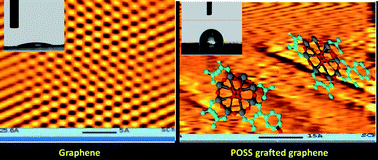Butyl lithium assisted direct grafting of polyoligomeric silsesquioxane onto graphene†
Abstract
Polyoligomeric silsesquioxane (POSS) decorated graphene nanoplatelets were synthesized using n-butyl lithium (n-BuLi). The isolated topological defects present along the edges of graphite played a crucial role in the grafting process. n-BuLi specifically scavenged the protons from these defect sites. These reactive anionic centres generated in situ, react with the POSS. Various microscopic characterization techniques indicated functionalization of the edges of graphene nanoplatelets. Further, highly exfoliated graphene layers were observed after modification. The present functionalization technique avoids the use of harsh oxidation techniques of graphite, which are commonly used for secondary modification of graphene.


 Please wait while we load your content...
Please wait while we load your content...